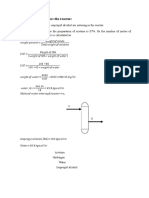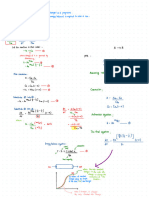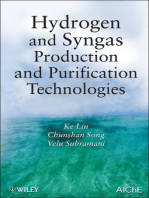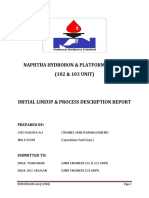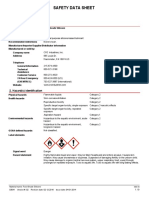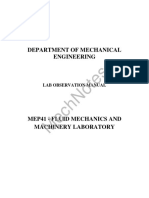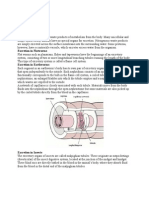6 PDF
Uploaded by
Muhammad6 PDF
Uploaded by
MuhammadCHAPTER 6 Reactor Design
Reactor Design
6.1 Theory of Reactor Design:
Heterogeneous catalytic reactors are the most important single class of reactors utilized by
chemical industry. Whether their importance is measured by the whole sale value of goods
produced, the processing capacity or the overall investment in the reactors and associated
peripheral equipment, there is no doubt as to prime economic role that reactors of this type play
in modern technology society.
The types of reactors used in industry for carrying out heterogeneous catalytic reactions
may be classified in terms of relatively small numbers of categories. One simple means of
classification is in terms of relative motion of the catalyst particles and reactants.
Reactors in which the solid catalyst particles remain in a fixed position relative to one
another (fixed bed, trickle bed and moving bed reactors).
Reactors in which the particles are suspended in a fluid and are constantly moving about
(fluidized bed and slurry reactors).
6.1.1 Fixed Bed Reactors:
In its most basic form a fixed bed reactor consists of a cylindrical tube filled with catalyst
pellets. Reactants go through the catalyst bed and are converted in to products. Fixed bed
reactors are often referred to as packed bed reactors. They may be regarded as the work horse of
the chemical industry with respect to number of reactors employed and the economic value of
materials produced. Ammonia synthesis, sulphuric acid production (by oxidation of SO2 to SO3)
and nitric acid production (by ammonia oxidation) are only a few of the extremely high tonnage
process that make extensive use of various forms of packed bed reactors.
The catalyst constituting the fixed bed will generally be employed in one of the
following configurations:
» A single large bed
» Multiple horizontal beds supported on trays arranged in a Vertical stack
Hydrodesulfurization Of Diesel Page 75
CHAPTER 6 Reactor Design
» Multiple parallel packed tubes in a single shell
» Multiple beds each in their own shell
The use of multiple catalyst sections usually arises because of the need to maintain adequate
temperature control with in the system. Other constraints leading to the use of multiple beds
include those of pressure drop or adequate fluid distribution. In addition to the shell and tube
configuration, some of possibilities for heat transfer to or from fixed bed reactors include the use
of internal heat exchangers, annular cooling spaces or cooling thimbles are circulation of a
portion of the reacting gases through an external heat exchanger.
The packing itself may consist of spherical, cylindrical or randomly shaped pellets, weir
screens or gauzes, crushed particles or a variety of other physical configurations. The particles
usually are 0.25 to 1.0 cm in diameter. The structure of the catalyst pellets is such that the
internal surface area far exceeds the superficial (external) surface area so that the contact area is
in principle, independent of pellet size. To make effective use of the internal surface area, one
must use a pellet size that minimizes diffusional resistance with in the catalyst pellet but that also
gives rise to an appropriate pressure drop across the catalyst bed.
The most commonly used direction of reactant. Flow is down ward through the bed. This
approach gives a stable bed that will not fluidize, dance or lift out of the reactor. This approach
minimizes catalyst attrition and potential entrainment of catalyst fines. When processing
conditions are such that the reactor is subjected to wide variations in feed flow rates or when the
feed is a dense fluid, it is imperative that the flow direction be downward. The attendant
advantages of-downward flow is the tendency of bed to compress itself and the gravitation of
catalyst fines (resulting from attrition) down through the bed. Both phenomena may lead to
increased pressure drop and channeling or mal distribution of the flow. Up flow has the
advantage of lifting catalyst fines or fragmented particles from the bed there by avoiding
channeling and blockage of bed. However, this mode of operation is disadvantageous because it
may lead to unstable beds at high flow rates. It leads to dancing in a pulsating flow that caused
catalyst abrasion and in unusual circumstances may lead to fluidization.
A fixed bed reactor has many unique and value able advantages relative to other reactor
types. One of its prime attributes is its simplicity, with the attendant consequence of low costs for
construction, operation and maintenance relative to moving bed or fluidized bed operation. It
Hydrodesulfurization Of Diesel Page 76
CHAPTER 6 Reactor Design
requires a minimum of auxiliary equipment and is particularly appropriate for use in small
commercial units when investments of large sums for control, catalyst handling and supporting
facilities would be economically prohibitive-. Another major advantage of this mode of
operation is implicit in "fixed bed reactor" is that there are no problems in separating the catalyst
from the reactor effluent stream. In many fluidized bed systems catalyst recovery can be quite
troublesome and require substantial equipment costs. Another important attribute of fixed bed
reactors is the wide variation in space times at which they can be operated. This flexibility is
extremely important in situations where one is likely to encounter wide variations in the quantity
or quality of the feed stock to be processed. For example high temperatures or high pressure
reactions employing solid catalyst, economic considerations usually dictate that the process
becomes commercially viable only when a fixed bed reactor is employed.
For economical production of large amounts of product, fixed bed reactors are usually the
first choice, particularly for gas-phase reactions. Many catalyzed gaseous reactions are amenable
to long catalyst life (1-10 years); and as the time between catalyst changes outs increases,
annualized replacement costs decline dramatically, largely due to savings in shutdown costs. It is
not surprising, therefore, that fixed-bed reactors now dominate the scene in large-scale chemical-
product manufacture.
Fixed-bed reactors may also be classified into two major categories according to the heat
requirements:
» Adiabatic fixed bed reactors
» Non-adiabatic fixed bed reactors
Hydrodesulfurization Of Diesel Page 77
CHAPTER 6 Reactor Design
6.1.2 Selection of Reactor Type:
After analyzing different configuration of fixed bed reactors we have concluded that for
our system the most suitable reactors are multi tube fixed bed reactor. Because Different reactor
configuration for fixed bed reactors are shown in table.
Classification Use Typical Applications
Moderately exothermic or
Mild hydrogenation
Single adiabatic bed endothermic non-equilibrium
limited
Where low ΔP is essential
Radial flow and useful where change Styrene from ethyl benzene
in moles is large
Adiabatic beds in High conversion, equilibrium SO2 oxidation, Catalytic
series with reforming, Ammonia
limited reactions
intermediate cooling synthesis, Hydro cracking,
or heating Styrene from ethyl benzene
Many hydrogenations
Highly endothermic or
Ethylene oxidation to
Multi-tabular exothermic reactions requiring
ethylene oxide, formaldehyde
non-adiabatic close temperature control to
by methanol oxidation,
ensure high selectivity phathalic anhydride
production
Direct-fired Highly endothermic, Steam reforming
non-adiabatic high temperature reactions
Hydrodesulfurization Of Diesel Page 78
CHAPTER 6 Reactor Design
Hydrotreating is highly exothermic reaction, so cooling will be required otherwise the
temperature of reactor will rise and due to rise in temperature the catalyst activity and selectivity
will be affected and in turn, the formation of by-products will increase which is direct loss of
productions.
As reaction temperature is already high 340 oC if we keep the process adiabatic,
temperature of reactor will rise and the structure of the catalyst will be changed and catalyst will
be damaged. For such a situation the best reactor is multi-tube fixed bed reactor.
6.1.3 Construction and Operation of Multi-Tube Fixed Bed
Reactor
Because of the necessity of removing or adding heat, it may not be possible to use a single large-
diameter tube packed with catalyst. In this event the reactor may be built up of a number of tubes
encased in a single body as illustrated in figure. The energy exchange with the surroundings is
obtained by circulating, or perhaps boiling, a fluid in the space between the tubes. If the heat
effect is large, each catalyst tube must be small (tubes as small as 1.0 in. diameter are widely
used) in order to prevent excessive temperatures within the reaction mixture. A disadvantage of
this method of cooling is that the rate of heat transfer to the fluid surrounding the tubes is about
the same all along the tube length, but the major share of the reaction usually takes place near the
entrance. For example, in an exothermic reaction the rate will be relatively large at the entrance
to the reactor tube owing to the high concentrations of reactants existing there. It will become
even higher as the reaction mixture moves a short distance into the tube, because the heat
liberated by the high rate of reaction is greater than that which can be transferred to the cooling
fluid. Hence the temperature of the reaction mixture will rise, causing an increase in the rate of
reaction. This continues as the mixture moves up the tube, until the disappearance of reactants
has a larger effect on the rate than the increase in temperature. Farther along the tube the rate will
decrease. The smaller amount of heat can now be removed through the wall with the result that
the temperature decreases. This situation leads to a maximum in the curve of temperature versus
reactor-tube length.
Hydrodesulfurization Of Diesel Page 79
CHAPTER 6 Reactor Design
Hydrodesulfurization Of Diesel Page 80
CHAPTER 6 Reactor Design
6.2 Effect of Variables on Multi-Tube Fixed Bed
Reactor:
Different parameters that affect the performance of fixed bed multi-tube reactor are:
6.2.3 Particle Diameter:
The overall heat transfer coefficient declines with decrease in particle size in the usual
practical range. Redial gradients increase markedly with decrease in particle size. Small size,
however, may improve rate or selectivity in some case by making catalyst inner surface more
accessible.
6.2.4 Tube Diameter:
Reducing tube diameter reduces the radial profile. Heat transfer area per unit volume is
inversely proportional to the tube diameter and reaction temperature is affected by a change in
this area.
6.2.5 Outside Wall Coefficient:
Improvement up to the point where this resistance becomes negligible is worthwhile.
Boiling liquids are advantageous because of the high heat transfer coefficient.
6.2.6 Heat of Reaction and Activation Energy:
Accurate values should be used since calculated temp. is sensitive to both of these, particularly
to the value of energy of activation. This must be determined carefully over the range of interests, but
calculated results should be obtained based on different activation energies over the probable range of
accuracy for the data so that final equipment sizing can be done with a feel for uncertainties.
6.2.7 Particle Thermal Conductivity:
One of the mechanisms of radial heat transfer in a bed, conduction through the solid
packing which must quite logically depend on the thermal conductivity of the bed, can be
reasoned to have some dependence on the thermal conductivity of the solid. But since it only
affects one of the several mechanisms, the proportionally cannot be direct. Differences in
effective conductivity and the wall heat transfer coefficient h between beds of packing having
high and low solid conductivity may be in the range of a factor of
Hydrodesulfurization Of Diesel Page 81
CHAPTER 6 Reactor Design
2-3. The largest difference will occur at lower Reynolds numbers. Most catalyst carriers have
low conductivities, but some such as carbides have high conductivities.
6.3 Preliminary Data for Reactor Design
Calculations:
Material Balance along the Reactor:
Reactor Inlet Reactor outlet
Temperature 340 oC 340 oC
Pressure 202 kPa 138 kPa
Mass Flow Rates (Kg/hr)
Total flow rate 178833.3 178833.3
Energy Balance along the Reactor:
Ref state: 25 oC and 101 kPa
Enthalpy of Reactants = -198782665 KJ kJ/hr
Enthalpy of products = 198978045.6 KJ/hr
Total Heat generated by reactions = - 872474.08 KJ/hr
Q load = -198782665 -872474.08 + 198978045.6
Q load = -677093.4 KJ/hr
Heat duty for cooling media = 677093.4 kJ/hr
Hydrodesulfurization Of Diesel Page 82
CHAPTER 6 Reactor Design
Reaction Phase:
Reactions are occurring in gaseous phase at 340oC and 202kPa in the presence
catalyst of NiO-MoO3 supported on alumina
6.4 Design Calculations:
6.4.1 Preliminary Calculations:
Reaction Kinetics:
C12H8S + 5H2 C12H16 + H2S
r1 (kmole/kgcat.sec) = k1CA k1 = 0.5 (m3/kgcat.sec)
Weight of catalyst:
On the basis of reaction
[( ) ]
Where,
Reactant Flow rate, = 9.836 x 10-3 (kmole/sec)
Reaction Constant, K1 = 0.5 (m3/kgcat.sec)
Hydrodesulfurization Of Diesel Page 83
CHAPTER 6 Reactor Design
Reactant Concentration, = 0 .0052 (kmole/m3)
Fractional Volume Change, = - 0.667
Conversion (First Rex), XA = 0.9
[( ) ]
W = 3670.18 kgcat
Type and volume of Catalyst:
A mixture of NiO-MoO3 having average particle size of 5mm is used as
catalyst in the process.
Bulk density of catalyst, ρc = 1200 Kg/m3
Bed void fraction, = 0.4
Volume of catalyst = 3670.18/1200
= 3.058 m3
Reactor Volume:
Reactor volume can be calculated as:
Vr = Vcat / (1 - )
= 3.058 / (1 - 0.4)
= 5.097 m3
Reactor Geometry:
Assuming tube length of 2.5 m and taking the diameter of tube to prevent
deviation from plug flow assumption. Dt/Dp > 10‡
Hydrodesulfurization Of Diesel Page 84
CHAPTER 6 Reactor Design
Where,
Dt = diameter of tube
Dp = diameter of particle
Tube Dimensions:
Tube outside diameter do = 60.45 mm
Tube inside diameter di = 52.50 mm (Schedule No. 40)††
Total number of tubes Nt
⁄
So, = 5.097 / ( /4 x 0.052502 x 2.5)
= 940
Assuming triangular pitch arrangement then
P = 1.25do
Where P = tube pitch
do = outside tube diameter
So, P = 0.07556 m
Hydrodesulfurization Of Diesel Page 85
CHAPTER 6 Reactor Design
Shell Inside Diameter:
Numbers of tubes at bundle diameter are gives as:
√[ ]
Where, ND = number of tubes at bundle diameter
So, ND = 35
Di PND 1
So, Shell inside diameter, Di = 2.75 m
Shell Height:
Length of tube = 2.5 m
Leaving 20 % spacing above and below
So height of shell = 2 (0.2 2.5) + 2.5
= 3.5 m
6.4.2 Pressure Drop Calculations:
Tube side pressure drop:
Using Eurgen equation.
ΔP 1 φ G 1501 φ μ
3 1.75G
L φ DPρf g c DP
= bed void fraction = 0.4
DP = particle diameter = 5 mm = 5 x 10-3
Hydrodesulfurization Of Diesel Page 86
CHAPTER 6 Reactor Design
ρf = feed density = 870 kg/m3
= viscosity of feed = 0.9 x 10-3 kg/m. Sec
gc = 9.80 m/sec2
L = length = 2.50 m
Total flow area = Nt . π/4. di2
= 940 x π/4 x 0.052502
= 2.039 m2
Total mass flow rate = 178333.308 kg/hr
Total mass flow rate = 49.53 kg/sec
So, Superficial mass velocity = 9.53 kg/m2.sec
Putting values in above eq. gives
ΔP = 787.34 kg/m2 = 7.61 kPa
Hydrodesulfurization Of Diesel Page 87
CHAPTER 6 Reactor Design
Shell side pressure drop:
Heat duty Q = = 677093.4 kJ/hr
Cooling media
Brackish water is used as a cooling media in the reactor to maintain its
temperature.
Specific heat capacity of water = Cp = 144.40 kJ/kmole-K
Temperature difference, ΔT = 20 K
Mass flow rate of water required:
Q = m.Cp.ΔT
677093.4 = m x 4.18 x 20
Mass flow rate, mw = 8014.25 Kg/hr
Mass flow rate, mw = 2.23 Kg/sec
Shell side flow area:
⁄ [ ]
Where, Di = shell inside diameter = 2.72 m
Nt = total number of tubes = 940
do = tube outside diameter = 0.06045 m
Ac = 3.11 m2
Hydrodesulfurization Of Diesel Page 88
CHAPTER 6 Reactor Design
Equivalent Diameter:
[ ⁄ ⁄ ]
[ ]
⁄ ⁄
Putting values in above formula
= 0.879 m
Shell side mass velocity = water flow rate / shell side flow area
= 2.23 / 3.11
= 0.71 kg/m2 - sec
Viscosity = 1.98 x 10-3 kg/m-sec
GDe
Reynolds Number Re
= 315.23
Friction factor for tube side, fs = 0.00514‡
Where
ΔPS = pressure drop
Gs = Shell side Mass velocity = 0.71 kg/m2.hr
Gs = 59459.8 lb/ft2/hr
L = length of tube = 8.2 ft
Nc = number of passes = 1
Hydrodesulfurization Of Diesel Page 89
CHAPTER 6 Reactor Design
De’ = Equivalent diameter = 3.015 ft
S = specific gravity = 0.87
= 1
Putting above values
ΔPS = 0.00145 psi = 0.01 kPa (negligible)
6.4.3 Calculations of Heat Transfer Co-efficient:
Shell Side:
For Shell side heat transfer coefficient
Where,
k = Thermal conductivity of cooling salt
= 0631 x 10-6 W/m-K
De‘= Shell side equivalent dia = 0.879 m
For Reynolds Number 315.23, JH = 9
Assuming, = 1
So,
Shell side heat transfer coefficient, ho = 2023.6 W/m2-K
Hydrodesulfurization Of Diesel Page 90
CHAPTER 6 Reactor Design
Wall Resistance:
( ⁄ )
Where,
Kw = Thermal conductivity of wall = 43.26 W/m-K
So, Rw = 8.63 x 10-5 m2-K/W
Tube Side:
An equation proposed by LEVA to find heat transfer co-efficient inside the
tubes filled with catalyst particles.
0.7 Dp
hi D DpG 4.6
3.5 e D
k μ
G = tube side mass velocity = 9.533 Kg/m2-sec
= viscosity of tube side fluid = 3.19 x 10-5 Kg/m-sec
k = 0.497 W/m-K
Dp = diameter of particle = 5 mm
D = Inside diameter of tube = 52.50 mm
Putting values in above equation
hi = 293.92 W/m2-K
Inside dirt coefficient:
hid = 2840 W/m2-K
Hydrodesulfurization Of Diesel Page 91
CHAPTER 6 Reactor Design
Outside dirt coefficient:
hod = 1704 W/m2-K
Over all H.T. Coefficient:
do = tube outside diameter = 60.45 mm
di = tube inside diameter = 50.50 mm
Ui = overall heat transfer on the basis of inside diameter
By putting the values
Ui = 210.8 W/m2-K
Area required for Heat Transfer
Q = 6.7 x 106 kJ/hr
LMTD = 87.1 oC
Area required for Heat Transfer = 364.89 m2
Area Available for Heat Transfer
Length of tube, Lt = 2.5 m
Inside Diameter of tube, di = 0.05045 m
= 940 x π x 0.05045 x 2.5
Hydrodesulfurization Of Diesel Page 92
CHAPTER 6 Reactor Design
= 372.45 m2
So sufficient area is available for heat transfer
6.5 Specification Sheet:
Reactor
Item: Fixed Bed Multi-Tubular Reactor
Function: To convert Dibenzotiophene into products by catalytic
hydrogenation.
Tube side: Catalyst weight = 3670 Kg
Material Handled: Pellet Size = 5mm
1) Reaction mixture Porosity = 0.4
consisting of sulfurous compound
Tubes:
2) Catalyst, Mixture of
NiO-MoO3 Outside diameter = 60.45mm
Flow Rate = 178333.3 Kg/hr Inside diameter = 52.50mm
Pressure = 202 kPa Schedule No. = 40
Temperature = 340 oC Tube length = 2.5 m
Reactor volume = 5.097 m3 940 tubes with triangular pitch are
aligned vertically in the shell
Hydrodesulfurization Of Diesel Page 93
CHAPTER 6 Reactor Design
Shell Side: Shell:
Fluid Handled = Cooling Shell Inside diameter = 2.75 m
Water
Shell Height = 3.5m
Heat Duty = 2.37 x 107 kJ/hr
Shell Thickness = 4.2 mm
Flow Rate = 181 Kg/sec
Construction Material = Carbon
Inlet Temperature = 340 oC Steel
Temperature Change = 20oC
Pressure = 101 kPa
Hydrodesulfurization Of Diesel Page 94
You might also like
- Hydrogen Production TechnologiesFrom EverandHydrogen Production TechnologiesMehmet SankirNo ratings yet
- Chapter 2 - Fundamentals of Fixed-Bed ReactorsNo ratings yetChapter 2 - Fundamentals of Fixed-Bed Reactors21 pages
- Design and Fabrication of A Multi-TubularNo ratings yetDesign and Fabrication of A Multi-Tubular14 pages
- Biodiesel Plant Optimisation Study by Using Aspen-HYSYS Process SimulatorNo ratings yetBiodiesel Plant Optimisation Study by Using Aspen-HYSYS Process Simulator5 pages
- Advanced Chemical Reaction Engineering CBE9450 ProjectNo ratings yetAdvanced Chemical Reaction Engineering CBE9450 Project21 pages
- En Analysis of Thermal Efficiency Limit of Steam Methane Reforming ProcessNo ratings yetEn Analysis of Thermal Efficiency Limit of Steam Methane Reforming Process8 pages
- Intrinsic Kinetics of Methanol Dehydration Over Al2O3 CatalystNo ratings yetIntrinsic Kinetics of Methanol Dehydration Over Al2O3 Catalyst6 pages
- Preliminary Design of Sodium Carbonate Plant: Darft Assignment 2No ratings yetPreliminary Design of Sodium Carbonate Plant: Darft Assignment 269 pages
- Energy Balances Procedure Single Component and Double Component System100% (1)Energy Balances Procedure Single Component and Double Component System24 pages
- Download full Solution Manual for Introduction to Environmental Engineering – SI Version, 3rd Edition all chapters100% (23)Download full Solution Manual for Introduction to Environmental Engineering – SI Version, 3rd Edition all chapters26 pages
- Wikisheet Three Phase Trickle Bed ReactorsNo ratings yetWikisheet Three Phase Trickle Bed Reactors6 pages
- Heat-Mass Transfer in A Tubular Chemical Reactor: Rehena NasrinNo ratings yetHeat-Mass Transfer in A Tubular Chemical Reactor: Rehena Nasrin11 pages
- Chemical Engineering Design and Analysis (049-076) PDFNo ratings yetChemical Engineering Design and Analysis (049-076) PDF28 pages
- Methanol Synthesis From Syngas in A Slurry ReactorNo ratings yetMethanol Synthesis From Syngas in A Slurry Reactor2 pages
- Modeling and Simulation of A Hydrocracking UnitNo ratings yetModeling and Simulation of A Hydrocracking Unit18 pages
- Acetone Reactor Design Complete Project PDFNo ratings yetAcetone Reactor Design Complete Project PDF29 pages
- Chemical Reactor Analysis and Applications for the Practicing EngineerFrom EverandChemical Reactor Analysis and Applications for the Practicing EngineerNo ratings yet
- Official IELTS Practice Materials 1 PDFNo ratings yetOfficial IELTS Practice Materials 1 PDF36 pages
- Hydrodesulfurization of Diesel: CHAPTER 1 IntroductionNo ratings yetHydrodesulfurization of Diesel: CHAPTER 1 Introduction6 pages
- Instrumentation and Control: 10.1 ObjectivesNo ratings yetInstrumentation and Control: 10.1 Objectives8 pages
- Food Premises Design and Construction Standards Plain100% (1)Food Premises Design and Construction Standards Plain14 pages
- A62 Life-Saving Fire-Fighting: XXXX A62B A62B XXXXNo ratings yetA62 Life-Saving Fire-Fighting: XXXX A62B A62B XXXX5 pages
- Effect of Polypropylene Fibres On Strength and Durability Performance of M-Sand Self Compacting ConcreteNo ratings yetEffect of Polypropylene Fibres On Strength and Durability Performance of M-Sand Self Compacting Concrete22 pages
- Technical Data Sheet HOJA TECNICA HOSTALEN CRP100 BLACKNo ratings yetTechnical Data Sheet HOJA TECNICA HOSTALEN CRP100 BLACK3 pages
- PRO/II Simulation of Bioethanol Production: What's InsideNo ratings yetPRO/II Simulation of Bioethanol Production: What's Inside12 pages
- Datasheets - High TG Material: General InformationNo ratings yetDatasheets - High TG Material: General Information3 pages
- 1823 - Eye Contour Cream-Gel (100.00g) Ingredient Function Percent WGT (G) WGT (Oz) Vol (TSP.) Phase ANo ratings yet1823 - Eye Contour Cream-Gel (100.00g) Ingredient Function Percent WGT (G) WGT (Oz) Vol (TSP.) Phase A1 page
- MSC Final Chemistry p4 Bioinorganic and Analytical Chemistry 2017 18No ratings yetMSC Final Chemistry p4 Bioinorganic and Analytical Chemistry 2017 184 pages
- DR Shilpa Hiremath, Quality Standards For DronapushpiNo ratings yetDR Shilpa Hiremath, Quality Standards For Dronapushpi8 pages
- Mechnotes: Department of Mechanical EngineeringNo ratings yetMechnotes: Department of Mechanical Engineering35 pages
- June 2015 MS - Unit 5 WJEC Physics A-LevelNo ratings yetJune 2015 MS - Unit 5 WJEC Physics A-Level15 pages
- Distillation Design and Control Using Aspen SimulationFrom EverandDistillation Design and Control Using Aspen Simulation
- Biodiesel Plant Optimisation Study by Using Aspen-HYSYS Process SimulatorBiodiesel Plant Optimisation Study by Using Aspen-HYSYS Process Simulator
- Advanced Chemical Reaction Engineering CBE9450 ProjectAdvanced Chemical Reaction Engineering CBE9450 Project
- En Analysis of Thermal Efficiency Limit of Steam Methane Reforming ProcessEn Analysis of Thermal Efficiency Limit of Steam Methane Reforming Process
- Intrinsic Kinetics of Methanol Dehydration Over Al2O3 CatalystIntrinsic Kinetics of Methanol Dehydration Over Al2O3 Catalyst
- Preliminary Design of Sodium Carbonate Plant: Darft Assignment 2Preliminary Design of Sodium Carbonate Plant: Darft Assignment 2
- Energy Balances Procedure Single Component and Double Component SystemEnergy Balances Procedure Single Component and Double Component System
- Download full Solution Manual for Introduction to Environmental Engineering – SI Version, 3rd Edition all chaptersDownload full Solution Manual for Introduction to Environmental Engineering – SI Version, 3rd Edition all chapters
- Heat-Mass Transfer in A Tubular Chemical Reactor: Rehena NasrinHeat-Mass Transfer in A Tubular Chemical Reactor: Rehena Nasrin
- Chemical Engineering Design and Analysis (049-076) PDFChemical Engineering Design and Analysis (049-076) PDF
- Methanol Synthesis From Syngas in A Slurry ReactorMethanol Synthesis From Syngas in A Slurry Reactor
- Chemical Reactor Design, Optimization, and ScaleupFrom EverandChemical Reactor Design, Optimization, and Scaleup
- Environmental Regulatory Calculations HandbookFrom EverandEnvironmental Regulatory Calculations Handbook
- Chemical Reactor Analysis and Applications for the Practicing EngineerFrom EverandChemical Reactor Analysis and Applications for the Practicing Engineer
- Hydrogen and Syngas Production and Purification TechnologiesFrom EverandHydrogen and Syngas Production and Purification Technologies
- Hydrodesulfurization of Diesel: CHAPTER 1 IntroductionHydrodesulfurization of Diesel: CHAPTER 1 Introduction
- Food Premises Design and Construction Standards PlainFood Premises Design and Construction Standards Plain
- A62 Life-Saving Fire-Fighting: XXXX A62B A62B XXXXA62 Life-Saving Fire-Fighting: XXXX A62B A62B XXXX
- Effect of Polypropylene Fibres On Strength and Durability Performance of M-Sand Self Compacting ConcreteEffect of Polypropylene Fibres On Strength and Durability Performance of M-Sand Self Compacting Concrete
- Technical Data Sheet HOJA TECNICA HOSTALEN CRP100 BLACKTechnical Data Sheet HOJA TECNICA HOSTALEN CRP100 BLACK
- PRO/II Simulation of Bioethanol Production: What's InsidePRO/II Simulation of Bioethanol Production: What's Inside
- Datasheets - High TG Material: General InformationDatasheets - High TG Material: General Information
- 1823 - Eye Contour Cream-Gel (100.00g) Ingredient Function Percent WGT (G) WGT (Oz) Vol (TSP.) Phase A1823 - Eye Contour Cream-Gel (100.00g) Ingredient Function Percent WGT (G) WGT (Oz) Vol (TSP.) Phase A
- MSC Final Chemistry p4 Bioinorganic and Analytical Chemistry 2017 18MSC Final Chemistry p4 Bioinorganic and Analytical Chemistry 2017 18
- DR Shilpa Hiremath, Quality Standards For DronapushpiDR Shilpa Hiremath, Quality Standards For Dronapushpi































